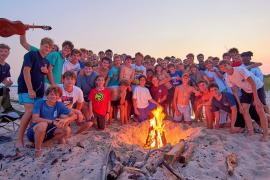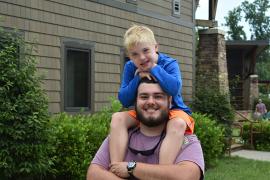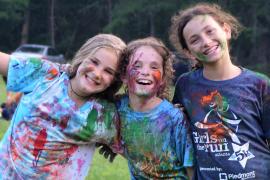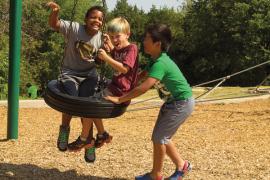". . We started him at a camp that didn’t like that he didn’t fit into their ‘normal’ box. They didn’t have the flexibility, tools, or understanding that you and your staff have. They didn’t listen, work with the family, work with outside resources, and, most importantly, take the time to get to know the child in order for them to be able to soar." — Camper parent email, August 2019
You just read part of a parent email that arrived with a week left to go in the summer of our first year with a focused full-inclusion program. The camper, whom I will call "Scott," had been slated to begin our second four-week session after first attending a different camp — the same camp his mother refers to in her email. After many incidents at his first camp along with several unhappy phone calls home, Scott left and came to us earlier than expected, joining us during week two instead of week four. Scott’s mother’s email goes on to describe the various components of inclusion we were able to provide for her son, many of which I will describe for you here. Let me begin, however, with some fundamental thoughts about inclusion.
Inclusion itself is not necessarily a tangible thing. It is a way of thinking about the individual needs of each camper that provides an opportunity for parents to have a role in advocating for the particular support their child needs, combined with ongoing feedback from the camp, for the good of the camper. In other words, inclusion is more than a checkbox or list of things to do to help kids who don’t fit into the "normal box." It is an ongoing, collaborative, and honest relationship among the parents, the camper, the staff, and even other agencies that know the child well, ensuring each child can take full advantage of the tremendous opportunities all kids can get from a positive camp experience. An example of the tools Scott’s mom referred to is a simple sheet of visual cues to replace verbal cues that we generated from a phone call we had with Scott’s team at school. These cues were boardmaker cards, visuals to replace verbal prompts for a camper. Removing the verbal language made it easier for Scott to process, and, ultimately, to comply with what we were asking him to do.
Scott’s mother’s email continued, "You gave him the strength, tools, and most importantly the courage to be himself. I am so proud of who he has become this summer, and a major part of it is because of the program at camp."
Scott was able to tap into the skills he had already established at his school and build on them at camp. Developing a plan for Scott took time, of course, as well as a willingness to collaborate with his parents and his school. For an inclusion program at any camp to be successful, the people involved must be willing to take the time to reach out to parents, schools, and any other agency that can give an accurate picture of what has and has not worked for a particular child.
Once we had some techniques, like the list of cues, all parties involved practiced a lot. Understandably, there were some failures and hard moments. How we responded to those setbacks made a significant difference and is what set this camper up to have the summer he did. We had to be authentic and determined in the commitment we made to the kids. Our rallying cry became, "These kids are our kids! They have as much right to be here as any other camper!"
Reframing "Inappropriate" Behavior
I regard "behavior" as a child trying to tell us something, often about a need they have that isn’t being met. Campers will succeed if we understand what their needs are and devise a plan to meet those needs within the confines of the camp program. Some children just don’t quite know how to tell us what they need — and some tell us too much. The sooner we can crack a camper’s behavioral "code," the sooner that camper can feel heard and begin to trust that the adults have their best interests at heart. To punish or shame a child for telling us what they need in the only way they may know how, even if we experience their behavior as inappropriate or unwanted, will actually cause that child to escalate the negative behavior. The way the inclusion and general staff react to these behaviors is critical to achieving success with that child. Having a calm, welcoming response to an upset camper will most certainly de-escalate most situations. At times, however, other tricks and tools are needed to best support kids.
Tips and Tricks to Try at Your Camp
The following suggestions are just that, suggestions. Each child is different, and finding what works involves a trial-and-error approach.
Transitions are challenging for most kids, but they can be especially challenging for kids who come under the umbrella of special needs. Time and space are easily the two things I use the most in the camp setting to help those campers.
- Time: Kids may just need a minute or two to get something out of their system or build up the confidence to say or do something.
Try: "I see that you may need some time, so I’ll check back in with you in a few minutes." - Space: Give a camper space by walking away while keeping an eye on them. When a camper is seeking attention, it is all right to not meet that need right away. We want to reinforce positive ways to seek attention.
Try: Stand with a colleague while a camper is taking their break. This way you are still in the vicinity to monitor but provide the camper privacy and a chance to practice their skills to get what they need.
General staff do not always have the time to devote to kids who may need more time to transition (and at day camp, there are multiple transitions each day). Having an adult "inclusion specialist" on staff who can step in while other staff are learning these techniques themselves is a solid plan. The point is to give the staff the tips and the opportunity to try them out with support from the inclusion specialist or camp social worker.
Sometimes time and space aren’t enough. Campers can be taught appropriate behaviors through positive reinforcement and reward, often in the form of free time. Always support these decisions with data presented in a way that the child understands. Consider using sticker charts on an index card, punching holes in a card, or a quick check-in at the end of an activity to review the target behaviors. Rewarding with free time might look like this:
- A camper who loves LEGOs (which aren’t always available) had a really good day. Take them to play with the LEGOs for five minutes and tell them why.
- Start the day by saying, "I know you really love the big wheel bikes. If you keep your hands to yourself, we can go ride one for a lap."
Individualized goals set with families through meaningful planning is a perfect way to address specific behavioral needs. Often if we see something at camp, the parents see it at home. Ask the family what works for them. The number of parents who haven’t been asked this about their children is sometimes alarming.
We don’t remove activities or make kids sit out of activities unless doing so is absolutely necessary. Removing a camper from an activity is punitive; it makes them feel ashamed. However, if you have exhausted all other options and the behavior persists, it may be a good idea to address the specific behavior right before the preferred activity. Setting your expectations at the activity the camper loves and enjoys can encourage them to practice desired behaviors in a positive way. Whenever you see the desired outcome from the camper, praise them, point it out in specific terms. "Johnny, you did great!" does not mean anything compared to "Johnny, I’m really proud of the way you waited in line patiently for the slide with your hands at your sides and having kind conversations with your friends." The second example can be used to teach the skill of waiting in line, and then you can work on transferring the acquired skill to other areas of camp.
Passing It up/Passing It on
Working with campers who have behavior issues daily can be an exhausting task. As camp directors, counselors, and other staff, we rely on each other to ease the burden and work toward great outcomes. We follow a model to "pass it on" or "pass it up." Passing it on refers to a horizontal shift from counselor to co-counselor — in other words, tag-teaming — to try and tackle a need. Passing it up means involving directors and/or other decision-makers at camp. This is particularly useful when safety is a concern or if the camper is negatively impacting those in their group.
Why Inclusion at Camp?
Inclusion at camp can be the reason a child has the best summer of their life. Allowing the camper who has had behavioral challenges or needs a chance to shine in your environment ensures they at least get a shot at a positive camp experience. Inclusion opens doors for families who feel their child hasn’t been given a fair shake because of something they struggle with.
It is true not all settings are appropriate for all campers. Some needs can’t be met at all facilities and locations. Regardless of that, the effort on the front end before the summer to discern what you can and cannot accommodate, and the effort during the summer to communicate with families what is happening, sets all parties up for success.
The first year of any new implementation can be a struggle. It for sure has bumps in the road. When thinking about the information your camp collects on enrolling campers, consider adding questions about functioning, following routines, and independence. It is also good to ask if there are supports in school. This information isn’t to tell the camper they can’t come, but rather an opportunity for dialogue between camp and family. Parent interviews are the best pre-summer tool I have. They open the door for partnership, growth together, solid understanding of camper needs, and sometimes collaboration with highly trained professionals in complementary fields. In one case, parent-provided information led to a behavior therapist attending camp with a camper. The therapist maintained constant contact with the camp’s inclusion specialist to ensure the best possible outcome for the camper.
The inclusion specialist position was widely accepted and used across camp this past summer. Staff came to me with questions about specific campers in their groups and how activities could be improved for their kids. Other directors partnered with me for weekly meetings to discuss any needs that were showing up in their groups or areas. Moving forward, I will be scheduled into every age level for activity periods to be more intentional with the campers to model positive outcomes.
Camp teams are made up of fantastic child specialists who want to see the best for the children who come to their camps. The inclusion specialist can be the point person for implementing data collection on campers, intervening in moments of camper upset, and having difficult conversations with families and campers. Overall, the whole camp benefits and the pull that behaviors can present is lowered.
Each child is different, so each child needs something different. If we operate with the "our kids" idea to create, plan, and implement camp, then we can provide one of the best developmental experiences for each child possible.
Matt is the inclusion specialist at Banner Day Camp in Lake Forest, Illinois. This will be his 11th year on staff there. During the year, Matt is a special education teacher and water polo coach in Skokie, IL. He will be finishing his master’s degree in Multicultural Education in the fall. Any questions can be sent to [email protected].




